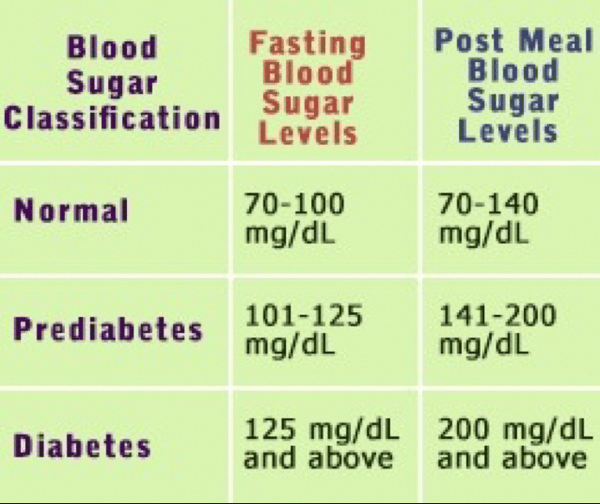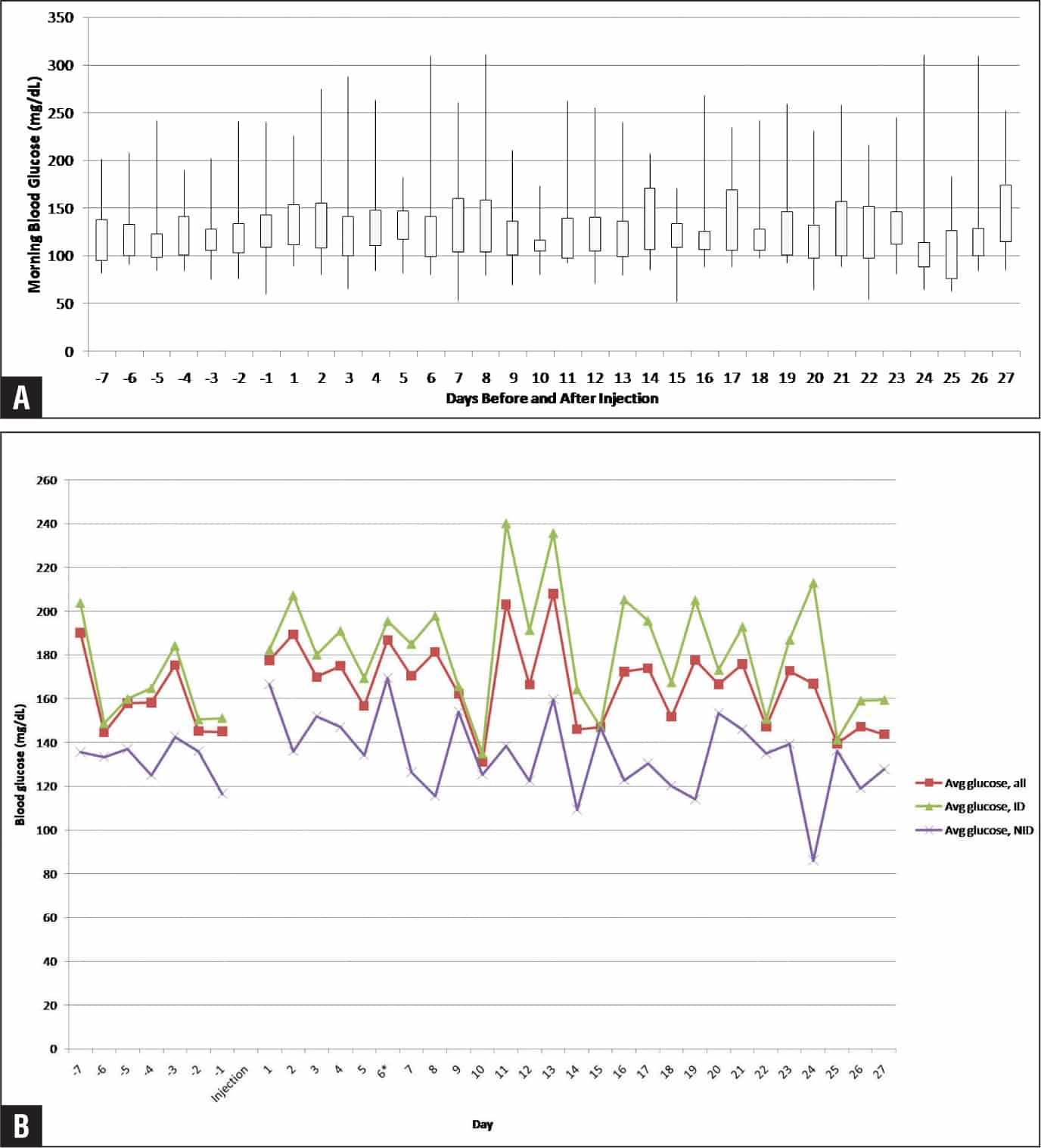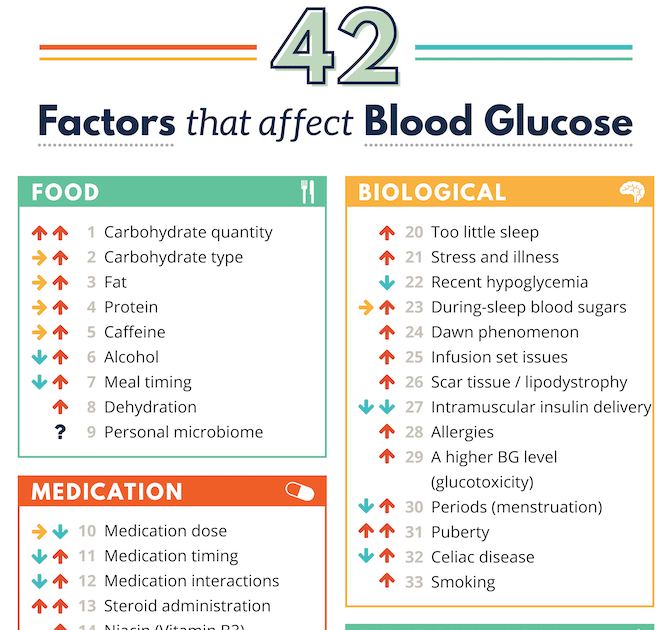Normal And Diabetic Blood Sugar Ranges
For the majority of healthy individuals, normal blood sugar levels are as follows:
- Between 4.0 to 5.4 mmol/L when fasting
- Up to 7.8 mmol/L 2 hours after eating
For people with diabetes, blood sugar level targets are as follows:
- Before meals : 4 to 7 mmol/L for people with type 1 or type 2 diabetes
- After meals : under 9 mmol/L for people with type 1 diabetes and under 8.5mmol/L for people with type 2 diabetes
High Blood Sugar: Hidden Dangers
In the short term, high blood sugar levels can zap your energy, cause excessive thirst and urination, and blur your vision. High blood sugar levels can also lead to dehydration, dry and itchy skin, and infections. Minimizing the time spent above your target blood sugar range can help you feel your best and will help prevent complications and injury to your body.
Over time, high blood sugar affects many parts of the body. Chronic high blood sugar can start to cause noticeable changes, including:
- Memory problems
- Vision problems like blurriness, diabetic retinopathy, and blindness
- Gum disease that leads to tooth loss, which can make eating healthy foods difficult due to problems chewing
- Heart attack and stroke due to increased plaque build-up in the vessels and other vascular issues
- Kidney disease, which can lead to the need for dialysis or a kidney transplant
- Nerve damage that can cause decreased sensation in the feet and legs which increases the risk for wounds to turn into serious infections and even amputation
Nerve damage from high blood sugar can also cause a variety of symptoms including:
- Pain and tingling in the feet and hands
- Difficulty emptying your bladder
- Problems during the digestion process after eating, which can cause food to sit in the stomach too long and lead to nausea, vomiting, and erratic blood sugar levels
Checking your blood sugar frequently and taking immediate action when it is above range can reduce your risk of complications.
When To See A Doctor
Knowing when to see your endocrinologist is important in the life of any person with diabetes and even their caretakers. Learn all about the blood sugar levels and their normal ranges to be able to understand what to look out for. In case of frequent lows, unmanageable highs, traces of ketones in the urine, continuous blurred vision, etc. visit your doctor. Ideally, you should be visiting them every 3 months after your HbA1c test.
Don’t Miss: How Much Sugar A Day To Get Diabetes
Why Your Blood Sugar Level May Be Low
If blood sugar drops below 70 mg/dL, it is below normal levels. This can be caused by a variety of factors, such as:
- Not eating enough or missing a meal or snack
- Reducing the amount of carbohydrates you normally eat
- Alcohol consumption especially if youre drinking on an empty stomach
- Taking too much insulin or oral diabetes medication based on carbohydrates or activity levels
- Increased physical activity
- Side effects from medications
If you have diabetes, keep your blood glucose meter and sources of fast-acting glucose close by in case your blood sugar drops. This is especially important for people with hypoglycemia unawareness, which is a condition that causes symptoms of low blood sugar to go unnoticed.
Eating balanced meals and snacks at regular times throughout the day is a big part of maintaining normal blood glucose levels. Check out our article on meal planning for diabetes to better understand the three macronutrients where calories come from and which have the biggest effect on blood sugar.
Meal Planning for Diabetes: How to Optimize Your Diet >
Everyone will respond differently to certain factors, which is why its important to have individualized target glucose levels. To help you reach your target blood glucose goals, work with your healthcare provider to discuss modifications to your diet, physical activity, or medications, and alert them of other factors like a recent illness or stressful event.
What Is Considered A Normal Blood Sugar Level

The normal blood sugar level for a healthy, non-diabetic adult is determined by when and how blood sugar levels are tested.
The below information describes what normal blood sugar levels are prior to and after meals and what the recommended HbA1c and Haemoglobin A1c levels are for those with and without diabetes.
If you are diabetic, it is advisable to consult with your doctor in order for appropriate blood sugar level targets to be set based on your age, the severity of your condition, medications taken and overall health status.
Don’t Miss: Type 2 Diabetes And Blood Pressure
Blood Sugar Levels Chart By Age 60 Female
As per the recommendations by Diabetes UK, here is a look at the target blood sugar levels for females who do not have diabetes:
| Level |
|---|
| 0-60 |
*Diabetes UK
As per the chart above, a healthy range of blood glucose in females above the age of 60 who do not have diabetes should be as per the following:
- 0 to 2 hours after the last meal was taken: 90 to 140 mg/dL
- 2 to 4 hours after the last meal was taken: 90 to 130 mg/dL
- 4 to 8 hours after the last meal was taken: 80 to 120 mg/dL
Do keep in mind that your doctor will give you the best suggestion about your target healthy blood glucose levels.
Other Severe Symptoms Of Hyperglycaemia Include:
- Blood vessel damage
Mild hyperglycaemia, depending on the cause, will not typically require medical treatment. Most people with this condition can lower their blood sugar levels sufficiently through dietary and lifestyle changes.
Those with type 1 diabetes will require the administration of insulin , while those with type 2 diabetes will often use a combination of injectable and oral medications , although some may also require insulin.
Recommended Reading: One Drop Chrome Blood Glucose Monitoring Kit
Oral Glucose Tolerance Test
The OGTT is a two-hour test that checks your blood glucose levels before and two hours after you drink a special sweet drink. It tells the doctor how your body processes sugar.
- Diabetes is diagnosed at two-hour blood glucose of greater than or equal to 200 mg/dl
|
Oral Glucose Tolerance Test |
| Normal |
| 200 mg/dl or higher |
Is 200 Blood Sugar Normal After Eating
Irrespective of what you had for your meal, a blood sugar level of 200 mg/dL or more highlights diabetes. Since the body takes time to process the food you had, you should always take your blood sugar readings after two hours of having a meal. It will give you a relatively accurate reading of your blood glucose levels.
Read Also: What To Do When Diabetic Blood Sugar Is Low
What Is A High Random Glucose Level
Often the blood sugar range is set and the concept of normal is defined. Random glucose means the reading on the blood glucose monitor at any non-specific point in the day. Any reading above the level of 150mg/dL might be considered high. While people may have varied definitions of what they may call high this number could be set as a baseline limit. A reading of 150 or even 160 may not require a correction dose. However, once the sugar levels move upwards and the readings go above, that is when action might be needed.
Another important factor that needs to be taken into consideration here would be why the random glucose is high. In case there is ongoing stress, the consumption of something sweet, improper injection of insulin, etc identify the cause and take appropriate action.
What To Expect From Your Blood Sugar In The Morning
After an overnight fast, a normal blood sugar level is less than 100 milligrams per deciliter , according to the American Diabetes Association . But, according to Susan Spratt, MD, an endocrinologist and associate professor of medicine at Duke University School of Medicine, not everyone with type 1 or type 2 diabetes has to shoot for “normal” levels.
“If you’re young, the goal may be to get your fasting blood sugar levels to less than 120 mg/dL,” Dr. Spratt says. But if you’re older and have other health conditions, that number may be higher, she says.
The ADA points out that not everyone will have the same blood sugar level goals. Instead, your endocrinologist or doctor will calculate your target number based on your age, how long you’ve had diabetes, whether you have health conditions like heart disease and other factors.
Keep in mind, too, that your fasting blood sugar levels can be too low. For example, a morning blood sugar reading below 70 mg/dL can indicate a hypoglycemia, or low blood sugar.
Read Also: Salty Taste In Mouth Diabetes
How Can High Blood Sugar Levels In The Morning Be Controlled
Once you and your doctor determine how your blood sugar levels are behaving at night, he or she can advise you about the changes you need to make to better control them. Options that your doctor may discuss depend on the cause of the morning high blood sugars.
For dawn phenomenon:
- Changing the timing or type of your diabetes medications
- Eating a lighter breakfast
- Increasing your morning dose of diabetes medication
- If you take insulin, switching to an insulin pump and programming it to release additional insulin in the morning
For Somogyi effect:
- Diabetes Forecast. Why Is My Blood Glucose So High in the Morning? Accessed 8/8/2018.
- American Diabetes Association. Somogyi effect, also called rebound hyperglycemia Accessed 8/8/2018.
- National Center for Biotechnology Information. Dawn Phenomenon. Accessed 8/8/2018.
Cleveland Clinic is a non-profit academic medical center. Advertising on our site helps support our mission. We do not endorse non-Cleveland Clinic products or services.Policy
Follow Your Diabetes Meal Plan

Make a diabetes meal plan with help from your health care team. Following a meal plan will help you manage your blood glucose, blood pressure, and cholesterol.
Choose fruits and vegetables, beans, whole grains, chicken or turkey without the skin, fish, lean meats, and nonfat or low-fat milk and cheese. Drink water instead of sugar-sweetened beverages. Choose foods that are lower in calories, saturated fat, trans fat, sugar, and salt. Learn more about eating, diet, and nutrition with diabetes.
Don’t Miss: Keto Pills Safe For Diabetics
What Is Continuous Glucose Monitoring
Continuous glucose monitoring is another way to check your glucose levels. Most CGM systems use a tiny sensor that you insert under your skin. The sensor measures glucose levels in the fluids between your bodys cells every few minutes and can show changes in your glucose level throughout the day and night. If the CGM system shows that your glucose is too high or too low, you should check your glucose with a blood glucose meter before making any changes to your eating plan, physical activity, or medicines. A CGM system is especially useful for people who use insulin and have problems with low blood glucose.
What Is Low Blood Sugar
Hypoglycaemia is a condition wherein blood sugar levels are too low. This condition affects a number of diabetic people when their bodies do not have enough glucose to use as energy. Hypoglycaemia is commonly the result of taking too much of the medication/s prescribed to treat diabetes, eating less than expected, exercising more than normal or skipping meals.
Some of the symptoms of hypoglycaemia include:
Don’t Miss: Why Buy Used Diabetic Test Strips
What Is The Somogyi Effect
A second possible cause of high blood sugar levels in the morning is the Somogyi effect, sometimes also called rebound hyperglycemia. It was named after the doctor who first wrote about it.
If your blood sugar drops too low in the middle of the night while you are sleeping, your body will release hormones in an attempt to rescue you from the dangerously low blood sugar. The hormones do this by prompting your liver to release stored glucose in larger amounts than usual. But this system isnt perfect in a person with diabetes, so the liver releases more sugar than needed which leads to a high blood sugar level in the morning. This is the Somogyi effect.
Why Does Blood Sugar Go Up In The Morning What Is The Dawn Phenomenon
There are a few main reasons why your glucose levels may be higher in the morning. One of these is known as the dawn phenomenon.
The dawn phenomenon occurs early in the morning between 3 am and 8 am while you are still asleep. As morning approaches, the body naturally signals your liver to produce glucose, giving your body the energy it needs for the start of the day. Caused by changes in hormonal levels, the dawn phenomenon happens to all people, with or without diabetes. However, for those without diabetes, insulin levels increase and they do not experience hyperglycemia.
Another reason you may experience higher morning glucose levels is because your injected insulin wears off. If your body has insufficient insulin during the night, your glucose levels may start to rise. To combat this, you may consider trying a new basal insulin, adjusting the timing and amount of your basal dose , or changing your nighttime basal rates .
The last reason you may experience higher morning glucose levels is known as the Somogyi effect. This occurs if your glucose levels fall too low during the night, caused by too much insulin or medication. To respond, your liver produces more glucose to try to maintain your glucose levels, which may result in hyperglycemia. The Somogyi effect is not as common as the other reasons described.
Don’t Miss: Does Smoking Contribute To Diabetes
What Is The Normal Level Of Sugar In The Blood
According to CDC, the Centers for Disease Control and Prevention, the following blood sugar level is the normal range that healthcare teams recommend for individuals who do not have diabetes.
| Result | |
|---|---|
| 140 mg/dL or lesser | Not Applicable |
While these are the recommended blood sugar levels for those who do not have diabetes, your healthcare provider will be able to give you the best target range for your blood sugar levels, based on other factors such as your age, overall health, any medications you are on and so on.
Recommended Target Blood Glucose Level Ranges
The NICE recommended target blood glucose levels are stated below for adults with type 1 diabetes, type 2 diabetes and children with type 1 diabetes.
In addition, the International Diabetes Federations target ranges for people without diabetes is stated.
The table provides general guidance. An individual target set by your healthcare team is the one you should aim for.
| Target Levels |
|---|
*The non-diabetic figures are provided for information but are not part of NICE guidelines.
You May Like: Symptoms Of Low Blood Sugar In Type 2 Diabetes
What Is The Ideal Blood Sugar For A 5
The normal blood sugar level for a five-year child should be around 80 mg/dL to 180 mg/dL. The normal range limit will keep narrowing as the child grows older. If you think your little one is at risk of developing diabetes, you should take regular readings and report any high levels to a doctor for immediate action.
How To Lower Morning Blood Sugar

Trying to learn how to lower morning blood sugar? Heres why your glucose levels rise in the morning and a few things you can try to keep them in range.
Waking up with high glucose levels may feel like it doesn’t make sense. You spend several hours asleep, not consuming any carbs, and yet somehow your glucose levels are still high when you wake up in the morning.
Why does this happen? What can you do to make sure your glucose levels are safely in range in the morning? Learn more about some tips on avoiding high morning blood sugar levels so you can start your day off right.
Read Also: Diabetes Type 2 A1c Goals
Lets Crunch Some Numbers
Ill give these numbers to you in a written, chart, and visual format because it will make sense to you depending how you read it.
Depending where you live in the world, numbers can vary slightly. And your numbers will either be mg/dl or mmol/l. Youll find the numbers for both of these readings below.
Normal Blood Sugar Levels
Fasting glucose 70-99 mg/dl or 4-6 mmol/l
2 hours post meal glucose Less than 140 mg/dl or less than 7.8 mmol/l
Pre-diabetes diagnostic ranges also called impaired fasting glucose or impaired glucose tolerance
Fasting glucose 100-125 mg/dl or 6.1-6.9 mmol/l
2 hours post meal glucose level 140-199 mg/ dl or 7.8-11 mmol/l
Type 2 Diabetes diagnostic ranges
Fasting glucose More than 126 mg/dl or more than 7.0 mmol/l
2 hours glucose level More than 200 mg/dl or more than 11.1 mmol/l
Target Blood Sugar Levels In Children With Diabetes
Children younger than 6 years old Blood sugar in mg/dL Bedtime 110-200
Children under 6 years of age should have blood glucose levels that range from about 80 to 200 mg/dL each day. This range is considered healthy, and the amount of glucose in a childs body will fluctuate from the time they wake up to after theyve eaten meals and again before bedtime. For this reason, kids with diabetes or hypoglycemic episodes may have to have their blood sugar levels tested in the middle of the night by their parents. Many children with type 1 diabetes wear a continuous glucose monitor , which displays glucose levels all the time and mostly eliminates the need for finger sticks.
Don’t Miss: What Kind Of Diabetes Do I Have